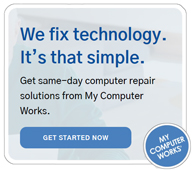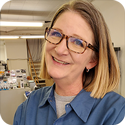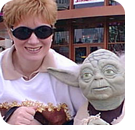|
In this issue ACCESSIBILITY: Welcome to assistive and adaptive technology Additional articles in the PLUS issue • Get Plus! FREEWARE SPOTLIGHT: CopyQ — I’m about to make your work way easier! SOFTWARE: Beyond Compare is beyond comparison PATCH WATCH: Printer bugs squashed this month
ACCESSIBILITY Welcome to assistive and adaptive technology
By Chris Husted The future of technology is in your hands, hands-free. Whether people know it or not, many of the latest features that make using the phone in their hand so much easier all came from developing “assistive and adaptive technology” (AAT), that branch of research and development specifically dedicated to help disabled people with their daily lives. More than 13 million Americans use assistive technology devices, reports the Centers for Disease Control and Prevention (CDC). But with the population aging, the number of people with vision impairment and age-related dexterity issues is growing. Chances are, you already use assistive technology or know someone who does. Stephen Dawes, a senior systems analyst for the local government Calgary, Canada, has lived the history of assistive and adaptive technology related to computers. He also foretells an interesting future. Stephen has been with the city of Calgary for more than 32 years. He works with computers all day. He is totally blind. All he sees is black. “I use assistive and adaptive technology every day to do my job,” he points out. One of the greatest leaps AAT has made in the past 20 years is the transition of “adaptive technology” to “assistive technology.” Stephen explains: “The difference is really in the name itself. Most people do not understand the difference. They are two different ways of interacting with technology. Assistive technology assists you to do different activities; adaptive technology enables you to use a device at all. The leap is usually when a device becomes software. “Siri can be considered assistive technology, as it can assist you to perform tasks on your phone. Adaptive technology is usually devices, such as a braille display, that show a visually impaired person what is on his phone, such as messages,” he adds. “We are really in the throes of evolution of assistive technology in the operating system. It is no longer in the primitive state it was years ago,” Stephen notes. “We’re now probably at the stage where the operating system is where third-party apps were 10 to 15 years ago, but the gap is closing very quickly. We might even say today that they are only five years behind. “For example, iOS has assistive technology built into it, to the point where you don’t need third-party apps just to interact with your device. But for Windows, to get a full, rich experience, you really need to go to a third-party app,” he says. The reason for the difference is in the genealogy of the two operating systems. “For many years, Microsoft relied on third parties to develop the technology. I believe Narrator did not arrive in Windows until Win95. It started as both assistive and adaptive technology. You needed a speech synthesizer as part of the package in order to have a screen reader work with the Windows OS. (A screen reader is text-to-speech software.) Today, you no longer need a speech synthesizer. The synthesized voices are now at the stage where they can be artificially generated,” Stephen explains.
“The Mac platform, however, even in its earlier days when it was in a Unix-style environment, could multitask better than Windows, and Apple made the effort to ensure that third-party apps complied with the App Store requirement to be fully functioning before they released it to the public.” With legislative requirements forcing operating systems to have basic assistive technology access available, the pressure has been on the operating-system developers to deliver this access — and that has highlighted key deficiencies. “Historically, third-party developers have been the ones reaching out to have their creations plugged into the operating system. Now they [the companies developing operating systems] have had to develop their own internal departments,” Stephen explains. “Third-party developers truly know the needs of their target market, but with major corporations it is only part of their overall operations. It is not their main focus,” he adds. Legislation and politics have been key drivers of integrating AAT into the main operating systems in use. But that may not be the driving force any longer, Stephen notes. “With the Americans with Disabilities Act, and for all people to have the same access to information as a Constitutional right, just those two pieces of legislation have really driven the advancement of assistive technology,” he says. “Another example would be Section 508 of the U.S. Rehabilitation Act of 1973. If you want a government contract, you have to comply with government regulations that require your software to enable people with disabilities to access the same information. “If companies want those contracts, then they have to comply with requirements — and by doing so, when they develop their technology to comply with those requirements, it gets folded into their mainstream product — and everyone benefits.” That model may have now gone the way of the dodo, Stephen notes. “In the future, the legislation will always be there and will always be the foundation, but it will no longer be the driver of AAT. Public adoption of AAT into the mainstream is going to be the next driver, or motivator, for these companies and how people interact with devices and apps. “When new technology arrives, quite often AAT has been an afterthought, but that is changing. I have to tip my hat to Apple for being the first to do this. When apps are made available through the App Store, they are first tested to make sure they work and comply with Apple Accessibility. “This gave Apple a clear advantage in lead time — by having AAT that already works available to the average user, far beyond the ‘target market’ the technology was created for. And this is how AAT ends up as standard everyday features in mainstream tech products.” The goal is for AAT to reach a state where it is so available that, when it is not there, it is considered missing. Companies will pay a price for that when their customers consider the company’s mainstream product as outdated or just deficient. “That is where we are now. AAT is moving to the Internet of Things,” he adds. “I can’t wait for the autonomous car to become mainstream, because then I’ll be able to drive.” “I need to be able to access the Internet, my emails, my messages, and my work docs. There will still be a need to provide that level of access. As new features arrive, they will have to work with existing accessibility. That is not driving AAT anymore — that is maintaining a level that the product is already at. The driver of the Internet of Things is going to be ease of access.” “We’re now seeing AAT in our homes. You can have smart home tech, but if it doesn’t work with voice-interactive systems such as Siri, Alexa, or Cortana, that product will fail. People are not going to install any smart home devices that do not work with these ‘assistants’,” Stephen says. “All of this is leading to ease of access. I use it because I need to use it, but anyone can now have an ‘assistant’ read their messages and even have their device reply just by speaking to it. “That’s my thinking. It is not the target market driving the bus. AAT has become so mainstream that adoption of technology will be the driver, the catalyst to keep advancing existing and evolving technology. If your new tech does not interact with voice-interactive tech, it is not going to make it.”
Chris Husted, who once upon a time was a junior computer column writer, is currently executive editor at The Phuket News. He has spent 20 years working in news in Phuket, with a one-year hiatus as a staff editor for a small national newspaper on Borneo. We thank long-time Plus member and IT expert Stephen Dawes for his contribution to this article.
The AskWoody Newsletters are published by AskWoody Tech LLC, Fresno, CA USA.
Your subscription:
Microsoft and Windows are registered trademarks of Microsoft Corporation. AskWoody, AskWoody.com, Windows Secrets Newsletter, WindowsSecrets.com, WinFind, Windows Gizmos, Security Baseline, Perimeter Scan, Wacky Web Week, the Windows Secrets Logo Design (W, S or road, and Star), and the slogan Everything Microsoft Forgot to Mention all are trademarks and service marks of AskWoody Tech LLC. All other marks are the trademarks or service marks of their respective owners. Copyright ©2022 AskWoody Tech LLC. All rights reserved. |
||||||||||||||||||||||||














